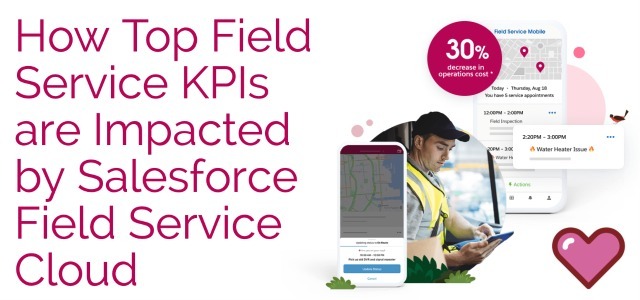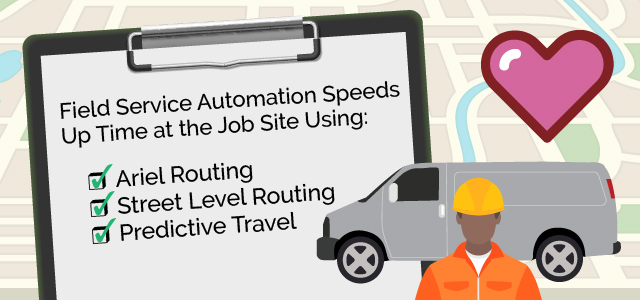How Top Field Service KPIs are Impacted by Salesforce Field Service
Estimated reading time: 5 minutes
In a recent episode of AdVic’s “Salesforce Simplified” podcast, we focused on Salesforce’s Field Service – and in particular – how its automation features have become a game-changer for field service teams. Our guest was Salesforce Senior Solutions Engineer, George Higgins.
An Overview of Salesforce Field Service
“Field service in general,” Higgins explains, “that’s a part of an organization that’s going to deploy a worker to actually go in person and perform a service for your customer, and that includes a lot of different use cases. There’s transportation, repair services, telecom, waste management, and financial services. All types of different in-person services are being provided across all types of different industries and that’s where Salesforce Field Service – part of a Salesforce Service Cloud solution – comes in. It’s an automated system that can really help with all the different moving parts that go into actually going on site and helping a customer solve their issue. You think about all the different factors that go into that. We need to schedule an appointment with the customer. Often that’s done with a service agent. Then somebody needs to actually dispatch a resource, and then that resource needs to show up to the appointment and actually help that customer. Field Service is built to kind of automate that process and optimize and give your customers that delighted experience they’re expecting.”
How Automation Improves Field Service Management
Without question, automation is a huge piece of the Salesforce Field Service solution. Higgins remarks, “There’s so many factors that go into executing out in the field. Does the tech have the right skill set? Can they actually help the customer? Are they physically close to the location? We obviously don’t want to be sending techs all across town if we don’t need to. Other factors such as, maybe a customer prefers a certain tech to come on site, and then also does that tech have all the materials with them to actually complete the work? Maybe a plumber doesn’t have all the right equipment on his truck that given day. Definitely don’t want him assigned to complete a job that requires that missing equipment. All those factors really multiply together and make it hard to find, what is that perfectly optimized schedule?”
He adds, “Automation is key, and of course, there’ll always be some need for a human element, but automation can really ease that burden on the dispatcher and help guide them towards scheduling that really helps your business, and ultimately, your customers in the most efficient way possible.”
Field Service Use Case Example
There were several use case examples Salesforce’s Higgins talked about during the podcast, but one in particular had to do with speeding up the time at a job site.
“There’s several different ways we can do this, and we do know that drive time, that per appointment travel time, is such a critical KPI for pretty much every Field Service organization, and we have a few different ways that we can help impact this KPI. There’s aerial routing, which is going to compute the shortest distance between two locations based on a straight line, so kind of as the crow flies. We also do street level routing, which is going to compute the distance along roads or transportation routes. It’s based on actual road speed measurements and the expected travel speed based on the type of road.”
Additionally, Higgins pointed out, “We also have predictive travel, so that builds on top of that street level routing and it incorporates time of day data into the calculation. Is it rush hour or is this generally a busy time on this road? We’ll factor that into what that drive time’s actually going to be. Lastly, we also have point to point predictive routing. That’s going to estimate travel time using the exact service appointment location, and it also considers that time of day. That’s the routing that is used across all scheduling and optimization operations within Field Service.”
Improving Customer Retention
Higgins highlighted several ways that Field Service automation helps with customer retention.
“There’s the unseen ways to the customer that happen behind the scenes that ensure the right tech is coming, they arrive when we’re expecting them to arrive, they do have the ability to fix my problem, and they’re able to do it on that first time. “
“Additionally, Higgins explained, “customers can now get that DoorDash or Uber-like real-time location experience that’s starting to become expected, and not just a nice to have. With appointment assistants, something a lot of our Field Service customers are adding on, you’re able to see on your phone, you can get text notifications, ‘Here’s the driver who’s on your way. It’s Alan. He’s 20-minutes away and here’s where he is on a map,’ getting that real-time location. That experience is something customers are expecting and we’re able to offer it with Field Service and it definitely helps with customer retention.”
There is much more to our conversation with Salesforce’s George Higgins. Listen to the entire podcast here. And if you would like to explore other ways a Salesforce Field Service solution can benefit you business, the AdVic Field Service Team is just a click away.
Related Resources:
Top Field Service KPIs Impacted by Field Service Cloud (Podcast)
Energize Salesforce Service Cloud with Field Service
3 Ways to Unleash the Speed and Efficiency of Your Field Service Operation
Subscribe to the AdVic Salesforce Blog on Feedly:




